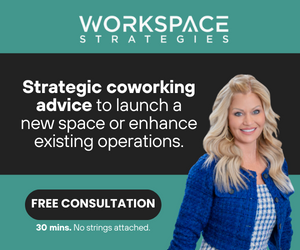- Grey space presents a number of opportunities within the commercial real estate sector for occupiers and workspace operators alike.
- 3.2 million square feet of grey space has hit the market since Covid-19, representing 106% growth over the last 12 months.
- This presents an opportunity for the original tenants to fit out the space to a higher quality, or partner with a flexible space operator to create a premium experience.
As a term, ‘grey space’ isn’t exactly inspiring. It sounds like a murky drizzly Monday.
Leaving aside any negative connotations, grey space presents a number of opportunities within the commercial real estate sector for occupiers and workspace operators alike.
Let’s start with a definition:
In the CRE industry, when a tenant decides to vacate all or part of their office space while still within the lease period, the part they leave behind is known as grey space. Rather than leaving it empty, which is extremely costly, they lease it out; effectively subletting the space to another tenant.
Grey space can occur at any time. But a significant amount of grey space has been released since the start of the pandemic.
According to research from Savills, 3.2 million sq ft of grey space has hit the market since Covid-19, representing 106% growth over the last 12 months.
During a webinar hosted by Richard Morris, Sales & Marketing Director at technologywithin, a panel of speakers offered thoughts and insights into what’s driving this trend and how grey space can serve an important purpose during the current climate.
Why is so much grey space being released now?
Morris noted that the pandemic has created a reason for organisations to review their property footprints, both as an immediate cost-cutting exercise but also in response to long-term changing work patterns.
With more people working remotely and in a hybrid way than ever before, companies realise they simply don’t need as much space as they did pre-Covid. And for those that are stuck in long-term leases, creating grey space and subletting it to another tenant offers a viable solution.
For the companies taking up grey space, it’s often cheaper than taking out a brand-new lease. It’s often available on shorter and more flexible terms and in some cases, the space is semi-fitted out too.
After all, it’s in the interest of the original tenant to create an attractive space that can be rented out quickly; the sooner it’s let, the sooner they can start recouping some of their property rental costs.
However, grey space isn’t normally premium quality.
Tenants prefer to keep the best part of the space to themselves, according to Zoe Ellis-Moore from Spaces to Places, and sublet the less desirable part. But this isn’t necessarily the best strategy.
“Getting people back into the office is not just about heads-down working; employees are demanding better quality. They want quality air ventilation and a better workplace experience. Employers need to provide a premium experience to draw people back in.”
That means a low grade sublet space may not be enough to encourage employees to come back to the office.
This presents an opportunity for the original tenants to fit out the space to a higher quality, or partner with a flexible space operator to create a premium experience.
The experience is indeed essential in drawing people to the workspace, noted Andrew Butler from Inc Spaces, as people have spent the past year forming new work habits and they now need a very compelling reason to come back to the office.
“Companies now have a workforce which has changed fundamentally. It takes around 30-35 days to form a new habit, and after 12 months of working from home, previous work-related habits have been broken.”
This means that one way or another, change is coming.
“The end user wants choice. They don’t want to commute anymore, it’s expensive and tiring. Real estate will survive but it will have to rethink itself.”
So, what’s the best way to navigate grey space? Is there a place for it in the flexible space sector?
Emma Swinnerton from Cushman & Wakefield is not surprised by the increase in grey space, given the need to cut costs as well as the changing work patterns, with many workforces now expected to continue working flexibly and in a hybrid way for the foreseeable future.
With that in mind she said grey space is “an obvious area to explore”, but it should not simply be dropped on the flex space sector.
“Historically, flex was always the poor relation,” she said. “Landlords would look to flex as a solution for space that they couldn’t lease conventionally, but flexible space operators shouldn’t be associated with low-grade space.
“Flex actually requires a higher quality of space because it’s being used more frequently by a wider range of customers. In some ways, quality space is even more important in flex than traditional leases.”
Ellis-Moore added that while grey space is indeed typically sub-standard (even the name makes it sound “unwanted and soulless!”) flex space operators are often well-positioned to get the best out of it.
“There’s a host of flex space operators who can work with it; they’re innovative and have the ability to create a desirable space.”
For many operators, the big enabler will be their relationship with their landlord – and the more support the landlord can offer, the better the outcome.
“It is very much a partnership,” added Butler. “Without the discussions, support and engagement between landlords and operators, a lot of operators wouldn’t have made it through last 12 months.
“One winner in all of this is the end user. They will get a lot more choice, from the basic level right through to premium level space. Flex operators will need to be on their game and now more than ever, will need stronger engagement with landlords.”

 Dr. Gleb Tsipursky – The Office Whisperer
Dr. Gleb Tsipursky – The Office Whisperer Cat Johnson – Coworking Marketing Maven
Cat Johnson – Coworking Marketing Maven Angela Howard – Culture Expert
Angela Howard – Culture Expert Drew Jones – Design & Innovation
Drew Jones – Design & Innovation Andrea Pirrotti-Dranchak – Competitive Advantage
Andrea Pirrotti-Dranchak – Competitive Advantage Jonathan Price – CRE & Flex Expert
Jonathan Price – CRE & Flex Expert Jeremy Fennema – Tech Innovation Alchemist
Jeremy Fennema – Tech Innovation Alchemist







